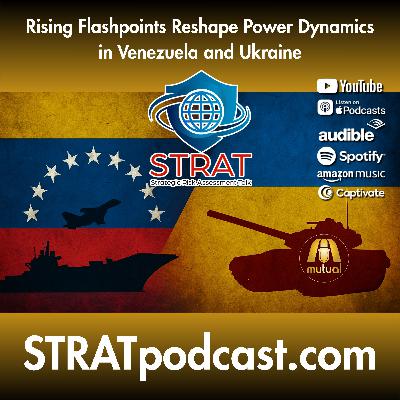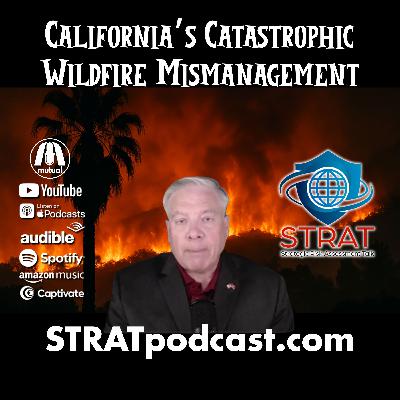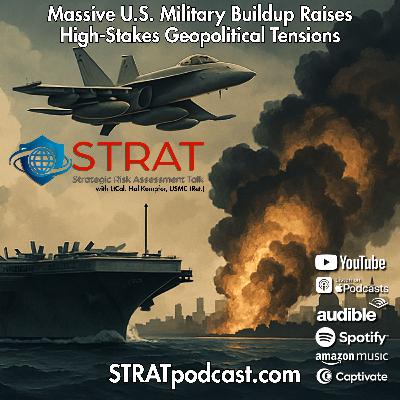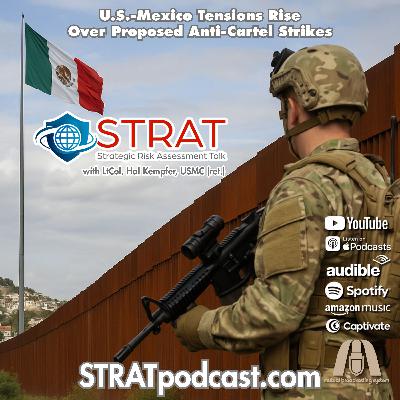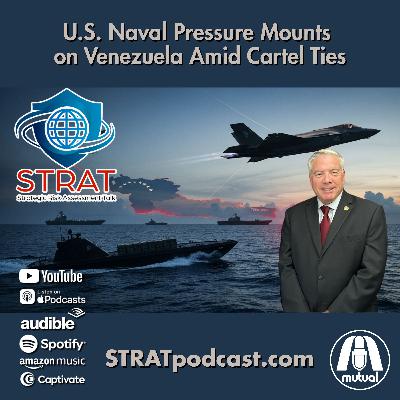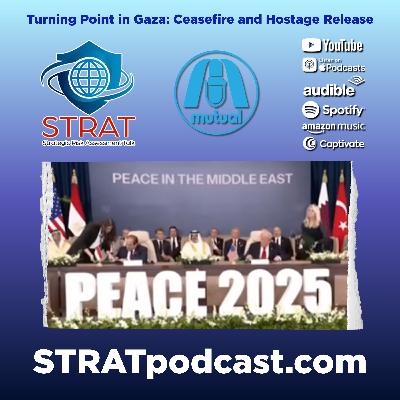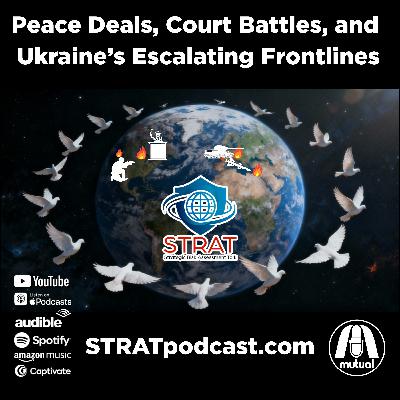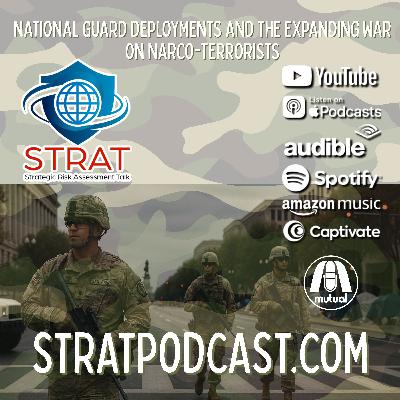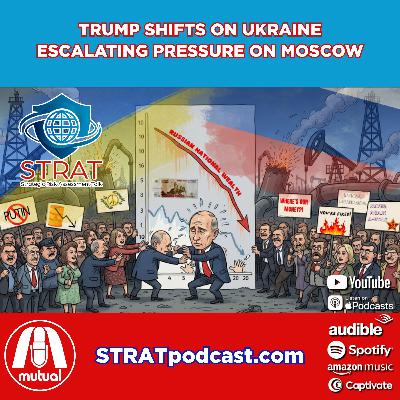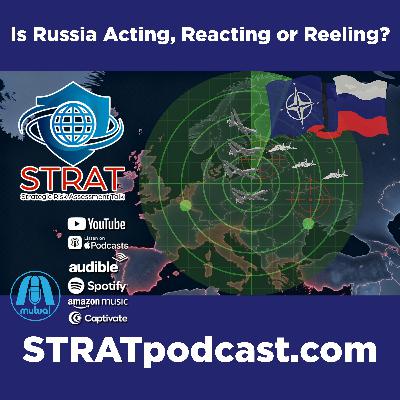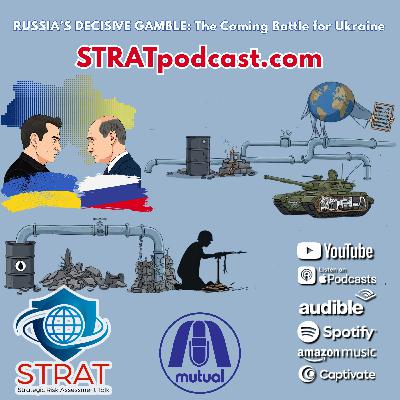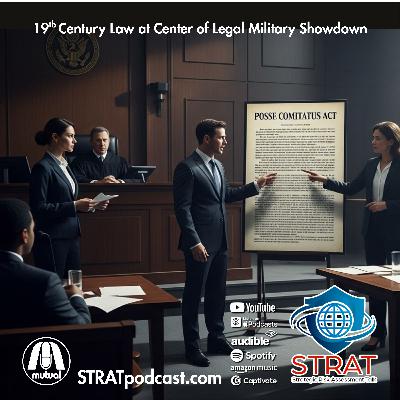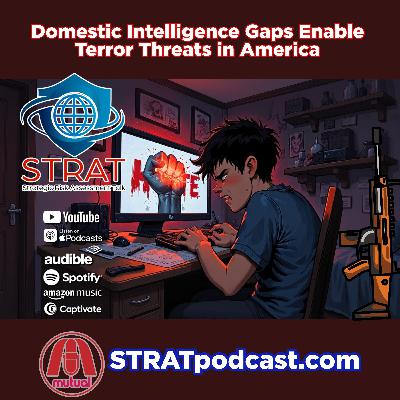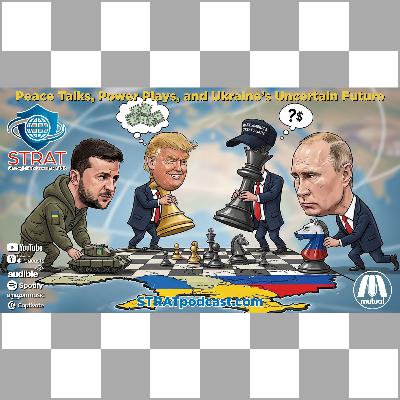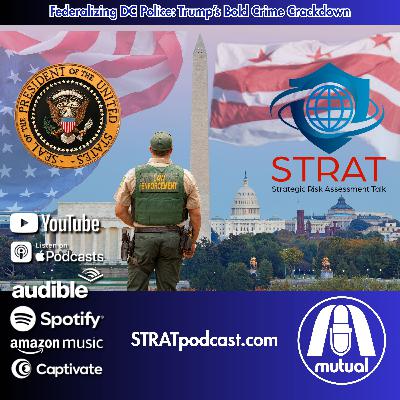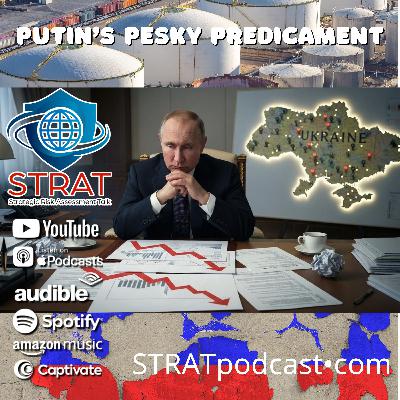Discover STRAT
STRAT

STRAT
Author: Mutual Broadcasting System LLC
Subscribed: 30Played: 396Subscribe
Share
© Copyright 2025 Mutual Broadcasting System LLC
Description
STRAT – Strategic Risk Assessment Talk, is a forum with a preparedness mindset. Mitigating risks, creating systems of prevention and recovery to deal with potential threats, and understanding the objectives of a Business Continuity Plan. This is the podcast for leaders who are committed to being prepared. The program is hosted by retired Marine Corps intelligence officer and strategic risk assessment professional Hal Kempfer and investment banker Mark Mansfield.
87 Episodes
Reverse
In this episode of STRAT, retired Marine Intelligence Officer Hal Kempfer examines two rapidly evolving geopolitical flashpoints—Venezuela and Ukraine—each perched at critical strategic inflection points. Venezuela faces mounting U.S. military and diplomatic pressure after President Trump’s declaration closing its airspace and the deployment of a powerful U.S. naval task force to the Caribbean. The situation places both Washington and the Maduro regime in precarious positions as covert operations, international legal concerns, and escalating cartel designations reshape the stakes. Meanwhile, Ukraine confronts a controversial peace plan that mirrors longstanding Russian objectives, raising fears about territorial concessions, regime change, and the future of Western commitment. With negotiations spanning Geneva to Washington and political turmoil in Kyiv, the outcome could redefine European security—while signaling broader implications for NATO, global alliances, and U.S. resolve in the Indo-Pacific. A complex and consequential moment is unfolding on both fronts.Takeaways:· Why U.S. pressure on Venezuela has reached a decisive point.· Strategic implications of closing Venezuelan airspace.· Capabilities and options of the U.S. carrier and MEU task force.· How cartel terrorist designations broaden potential U.S. target sets.· Concerns over reported Navy conduct and international law.· Why Ukraine’s proposed peace plan aligns closely with Russian aims.· How political instability in Kyiv and global negotiations shape outcomes.· Broader risks for NATO, Europe, and U.S. commitments worldwide.#STRATPodcast #HalKempfer #MutualBroadcastingSystem #StrategicRiskAnalysis #Geopolitics #NationalSecurity #VenezuelaCrisis #UkraineWar #USForeignPolicy #MilitaryStrategy #IntelAnalysis #RussiaUkraine #SouthAmericaSecurity #NATOAllies #GlobalStability #DefenseInsights #PolicyAnalysis #SecurityBriefing #InternationalRelations #RiskAssessment
California’s recent wildfire tragedies reveal far more than natural disaster—they expose deep failures in federal oversight, intelligence integration, emergency preparedness, and state-level accountability. In this episode, retired Marine Intelligence Officer Hal Kempfer examines why California continues to suffer catastrophic losses despite receiving substantial federal resources for prevention, mitigation, and consequence-management intelligence. Using the deadly Palisades fire as a case study, we break down allegations of state interference with firefighting operations, incomplete suppression of earlier burns, unfulfilled fuel-reduction promises, and years of misrepresented accomplishments in wildfire prevention. Kempfer also traces the history of federal all-hazards intelligence programs, how they were designed to support state and local decision-makers, and how California’s leadership rejected or redirected critical DHS-funded initiatives—hindering capabilities that could have saved lives and communities. Finally, Hal explores why a comprehensive, long-look federal investigation is urgently needed to address the systemic issues that span multiple administrations and continue to put millions at risk.Takeaways:· The Palisades fire exposed major failures in California’s fire-prevention and emergency-management systems.· New allegations suggest state officials may have limited key firefighting actions before the deadly blaze.· Investigations show California overstated wildfire-prevention accomplishments by hundreds of percent.· Fuel-reduction commitments were reduced or delayed despite repeated public claims of progress.· DHS-funded intelligence programs meant to support emergency operations were halted by state leadership.· California’s actions also affected other states seeking to implement all-hazards intelligence programs.· Comprehensive consequence-management intelligence could have reduced losses in multiple disasters.· A federal investigation—independent of DHS OIG—is needed to examine systemic misconduct across administrations.#STRATPodcast #HalKempfer #MutualBroadcastingSystem #StrategicRiskAnalysis #WildfirePrevention #EmergencyManagement #CaliforniaFires #PalisadesFire #HomelandSecurity #DisasterPreparedness #ConsequenceManagement #FederalOversight #CrisisResponse #WildfirePolicy #PublicSafety #IntelligenceAnalysis #EmergencyResponse #GovernmentAccountability #RiskMitigation #DisasterResilience
In this episode, retired Marine Intelligence Officer Hal Kempfer breaks down the newly announced Operation Southern Spear, a major U.S. military action aimed at targeting narco-terrorist networks in Latin America. With the USS Gerald R. Ford carrier strike group and an Amphibious Ready Group deploying to the region, the buildup represents one of the most significant demonstrations of American power in South America in generations. We examine what this force can actually do, what it can’t, and how its presence is being interpreted by Venezuela and regional actors. The episode also explores rapidly evolving Middle East diplomacy: the U.S. envoy’s potential meeting with Hamas leadership, Saudi-Israeli normalization talks tied to F-35 sales, and competing U.N. resolutions shaping the future of Gaza. Could these developments signal the emergence of a much larger geopolitical deal? We walk through the complexities, risks, and potential outcomes shaping the global landscape.Takeaways:Operation Southern Spear signals a major U.S. military escalation in Latin America.The USS Gerald R. Ford and Marine Expeditionary Unit form a powerful but non-invasion strike force.Venezuela accuses the U.S. of manufacturing pretexts for regional intervention.Debate intensifies over whether drug cartels meet the FBI’s definition of terrorist organizations.U.S. envoy’s planned meeting with Hamas sparks criticism over timing and intent.Saudi-Israeli normalization increasingly tied to F-35 sales and U.S. diplomatic leverage.Competing U.N. proposals reveal fractures over Gaza’s future and transitional governance.A potential “grand deal” may be forming across Latin America and the Middle East.#STRATPodcast #HalKempfer #MutualBroadcastingSystem #StrategicRiskAnalysis #OperationSouthernSpear #USMilitary #MiddleEastCrisis #VenezuelaTensions #GeraldRFord #MarineExpeditionaryUnit #GazaCeasefire #Hamas #SaudiIsraelNormalization #F35Deal #Geopolitics #NationalSecurity #DefenseAnalysis #MiddleEastPolicy #LatinAmericaSecurity #GlobalStrategy
In this episode of STRAT, retired Marine Intelligence Officer LtCol. Hal Kempfer examines the explosive proposal under consideration by the Trump Administration: U.S. military strikes against Mexico’s drug cartels. Kempfer explores how these criminal organizations dominate narcotics trafficking into the United States and perpetuate extreme violence and corruption in Mexico. He traces America’s long, complex military history south of the border—from the Mexican-American War to modern counter-narcotics cooperation—and unpacks how those memories shape today’s political and security dynamics. With reports of training and intelligence coordination already underway, and Mexico’s own government intensifying operations against the cartels, Kempfer dissects the strategic, legal, and geopolitical implications of a potential U.S. intervention. This episode sheds light on the razor’s edge between partnership and provocation—and what renewed military involvement could mean for both nations.Takeaways:· Mexican cartels are the primary suppliers of illicit drugs into the U.S.· “Plata o Plomo” encapsulates cartel violence and corruption.· The U.S. has a long and contentious military history in Mexico.· The Merida Initiative symbolizes modern cooperation but raises sovereignty concerns.· Intelligence-sharing between nations remains fraught with mistrust and complexity.· Trump Administration discussions involve potential covert and overt U.S. operations.· The CIA and Special Operations Forces may play a leading role under Title 50.· Any U.S. action risks rekindling deep Mexican sensitivities about foreign intrusion.#STRATPodcast #HalKempfer #MutualBroadcastingSystem #StrategicRiskAnalysis #Mexico #DrugCartels #NarcoTerror #USMilitary #TrumpAdministration #FentanylCrisis #BorderSecurity #MeridaInitiative #IntelligenceOperations #CIA #SpecialOperations #Title50 #Geopolitics #USMexicoRelations #NationalSecurity #CounterNarcotics
In this episode of STRAT, retired Marine Intelligence Officer LtCol. Hal Kempfer analyzes escalating U.S. military operations targeting fast boats and semi-submersibles linked to narcotics trafficking in the Caribbean and East Pacific. He explores the mounting tension between Washington and Venezuela as American naval and air forces, including F-35s and strategic bombers, position off the Venezuelan coast. With the Maduro regime accused of deep ties to the Soles cartels—designated as a terrorist organization—Kempfer examines how the U.S. is framing the mission under counterterrorism logic. He also discusses the geopolitical stakes, the weakness within Venezuela’s military, and whether growing U.S. actions could precipitate the fall of Nicolás Maduro’s government.Takeaways:· The U.S. has launched strikes on cartel-linked vessels in the Caribbean and East Pacific.· A Marine Expeditionary Unit and carrier task force are operating off Venezuela.· F-35s are based in Puerto Rico, signaling possible escalation.· The FAA’s extended airspace warning hints at planned operations.· Maduro’s regime is tied to the Soles and Tren de Aragua cartels.· U.S. actions may include leadership strikes if cartels equal terrorism.· Maduro’s fall could reshape Venezuelan politics and U.S. influence.· Strategic calculations suggest the U.S. cannot afford inaction.#USMilitary #Venezuela #MaduroRegime #DrugCartels #NarcoTerrorism #CaribbeanOperations #EastPacific #F35 #NavalStrike #Counterterrorism #WesternHemisphere #ForeignPolicy #MaritimeSecurity #Geopolitics #MilitaryStrategy #LatinAmerica #STRATPodcast #HalKempfer #MutualBroadcastingSystem #StrategicRiskAnalysis
On this episode of STRAT, we examine Ukraine’s FP-5 “Flamingo” cruise missile — a potentially game-changing long-range weapon now entering serial production. Retired Marine intelligence officer LtCol. Hal Kempfer walks through reported production rates, propulsion sourcing, warhead capabilities, and the strategic implications for Russian infrastructure and morale. We unpack claims about range, cost, and manufacturing scale; evaluate targets that suddenly fall within reach (refineries, rail chokepoints, weapons factories, command nodes); and consider how lower-cost mass production could reshape procurement and battlefield calculus. Discussion covers export and supply-chain angles, the possible US interest in the design or cost efficiencies, and political risks for Moscow if strikes reach population centers. Listeners will gain a clearer sense of how Flamingo changes deep-strike dynamics, what vulnerabilities Russia might face, and why industrialized, affordable cruise missiles matter to future warfare and deterrence. We end with policy options and scenarios.Takeaways:· Flamingo (FP-5) reportedly offers ~3,000 km range — deep-strike game changer.· Production is scaling quickly; Ukraine moving toward mass production capacity.· Unit cost reportedly far lower than US Tomahawk, enabling volume use.· Engines and components sourced creatively — raises proliferation and supply-chain questions.· Warhead options include bunker buster and cluster bomb units — wide target set.· 80–90% of Russian industrial targets could be within Flamingo range.· Strategic effects: strikes on refineries, rail, and weapons factories carry political risk for Moscow.· Wider implication: affordable cruise missiles could alter future procurement, deterrence, and escalation dynamics.#STRATPodcast #HalKempfer #MutualBroadcastingSystem #StrategicRiskAnalysis #FlamingoMissile #FP5Flamingo #UkrainianCruiseMissile #LongRangeStrike #DeepStrikeCapability #FirePoint #MissileProduction #LowCostCruise #CruiseMissileProliferation #RussianVulnerabilities #EnergyTargets #RailChokepoints #WarheadPenetration #PropulsionSourcing #MassedPrecisionFires #GeopoliticalConsequences
In this STRAT episode, retired Marine Intelligence Officer LtCol. Hal Kempfer breaks down three global and domestic flashpoints shaping today’s strategic landscape. First, he analyzes the latest diplomatic rift between Washington and Moscow, as talks between the U.S. and Russia collapse and Ukraine presses forward with new missile capabilities that could shift the balance of power. Next, Kempfer examines the fragile Gaza ceasefire, marked by violations, humanitarian struggles, and competing political agendas that threaten to reignite conflict. Finally, he unpacks a major Ninth Circuit Court decision authorizing the federalization of Oregon National Guard troops amid civil unrest — a ruling with profound implications for federal versus state authority. From Eastern Europe to the Middle East to America’s own legal battlegrounds, this episode offers critical insight into how military, legal, and geopolitical dynamics intersect in today’s complex world.Takeaways:· Russia’s demands in Ukraine remain unchanged despite diplomatic outreach.· The canceled Trump-Putin summit reflects rising U.S.-Russia tensions.· Ukraine’s domestic missile production could shift the war’s dynamics.· Flamingo missiles offer a cost-effective alternative to Tomahawks.· Gaza’s fragile ceasefire faces violations and humanitarian setbacks.· Hamas and Israel remain locked in a volatile political struggle.· The Ninth Circuit Court ruling reaffirms federal control of National Guard.· Historical parallels emerge between current federalization and 1960s civil rights crises.#UkraineWar #GazaCeasefire #MiddleEastCrisis #USPolitics #NationalSecurity #ForeignPolicy #MilitaryAnalysis #Geopolitics #GlobalAffairs #OregonNationalGuard #CourtDecision #TrumpAdministration #Putin #StateSovereignty #FederalAuthority #STRATPodcast #HalKempfer #MutualBroadcastingSystem #StrategicRiskAnalysis #DefenseInsights
In this episode of STRAT, retired Marine Intelligence Officer LtCol. Hal Kempfer examines one of the most pivotal developments in recent Middle East history—the ceasefire in Gaza and the release of Israel’s remaining live hostages. Kempfer analyzes how high-stakes diplomacy, coercive pressure, and regional alliances led to this breakthrough, and what challenges lie ahead in Phase 2 of the peace process. From Hamas’s disarmament and Gaza’s reconstruction to the possible normalization of relations between Saudi Arabia and Israel, Kempfer explores the complex military, political, and humanitarian implications shaping the region’s future. He also discusses how Gaza’s governance might evolve under a proposed Peace Board led by President Trump and Tony Blair. Tune in for expert insight into this critical moment and what it means for stability, peacekeeping, and long-term transformation across the Middle East.Takeaways:· The ceasefire and hostage release mark a major diplomatic breakthrough.· Intense pressure on both Israel and Hamas enabled the Phase 1 agreement.· President Trump and regional allies played key roles in securing terms.· Phase 2 involves disarming Hamas and ending its governance in Gaza.· A technocratic Palestinian body, possibly guided by Tony Blair, may oversee Gaza.· Reconstruction efforts will require international aid and regional investment.· Gaza faces deep social, infrastructural, and economic rebuilding challenges.· The deal could pave the way for Saudi-Israeli normalization.#STRATPodcast #HalKempfer #MutualBroadcastingSystem #StrategicRiskAnalysis #MiddleEast #GazaCeasefire #HostageRelease #Hamas #Israel #Trump #TonyBlair #PeaceProcess #GazaReconstruction #PalestinianAuthority #SaudiIsraelRelations #Diplomacy #IntelligenceAnalysis #Security #Geopolitics #Ceasefire
In this episode of STRAT, retired Marine Intelligence Officer Hal Kempfer examines three fast-moving global and domestic developments shaping today’s security landscape. First, Hal analyzes the new Gaza peace deal between Israel and Hamas — a fragile, phased agreement that could bring long-awaited hostages home but faces major hurdles in disarmament and governance. Next, he explores the Chicago federal court ruling halting National Guard deployments, unpacking constitutional questions and the broader implications for federal and state authority amid urban unrest. Finally, Kempfer provides a sharp situational update on Ukraine’s latest military actions, from deep strikes on Russian refineries to hybrid warfare operations across Europe. As global tensions intensify, Hal connects the dots between these stories to reveal what they mean for U.S. strategy, international stability, and the shifting balance of power worldwide.Takeaways:Israel and Hamas begin Phase I of a U.S.-backed peace deal.Hostage releases and troop withdrawals mark fragile first steps in Gaza.Phase II disarmament and governance talks could easily collapse.Chicago court halts National Guard deployment, citing constitutional concerns.Federal vs. state control of troops faces renewed legal scrutiny.Ukraine expands deep strikes on Russian targets and refineries.Russia’s economy and military momentum continue to falter.European nations brace for hybrid warfare and political realignments.#STRATPodcast #HalKempfer #MutualBroadcastingSystem #StrategicRiskAnalysis #GazaPeaceDeal #IsraelHamasCeasefire #NationalGuard #ChicagoRuling #UkraineConflict #RussianEconomy #HybridWarfare #GlobalSecurity #USMilitary #Ceasefire #HostageRelease #InternationalLaw #DefenseAnalysis #Geopolitics #CivilMilitaryRelations #WorldAffairs
In this episode, retired Marine Intelligence Officer Hal Kempfer examines the Trump administration’s fast-paced 2025 deployments of federalized National Guard troops to major U.S. cities. Framed by the Administration as a strategy to combat crime, immigration, and homelessness, the move has sparked nationwide debate over the use of the military and testing the limits of federal intervention in the homeland. From Los Angeles to Washington, D.C. and from Portland and Memphis, these deployments are redefining the balance of power between state and federal authority and spotlighting a “loophole” within the Posse Comitatus Act, wherein active-duty National Guard troops under federally funded Title 32 status are working for the state and potentially performing missions that are prohibited to federal troops under federal law. At the same time, President Trump has declared Mexican drug cartel members as ‘unlawful combatants’, signaling a dramatic shift in how these cartel members are to be handled, and coinciding with an expansion of U.S. military engagement in the Western Hemisphere.Takeaways: • National Guard deployments expanded from Los Angeles to Washington, D.C., and beyond. • Federal troops tasked with supporting ICE in logistics and enforcement. • Governors divided: some request support, others challenge deployments in court. • Legal disputes center on Posse Comitatus and Title 32 authority. • Oregon sued over deployments, citing risks to public safety. • Trump declares cartel members as “unlawful combatants,” putting them in the same status as Al Qaeda • Parallels drawn to post-9/11 legal precedents and controversies. • Growing shift of U.S. military focus to Western Hemisphere threats. #STRATPodcast #HalKempfer #MutualBroadcastingSystem #StrategicRiskAnalysis #NationalGuard #TrumpAdministration #BorderSecurity #ImmigrationEnforcement #PosseComitatus #Title32 #USMilitary #DrugCartels #UnlawfulCombatants #HomelandSecurity #FederalOverreach #PublicSafety #DomesticDeployment #WarPowers #TransnationalCrime #WesternHemisphere
In this episode, retired Marine Intelligence Officer Hal Kempfer unpacks President Donald Trump’s dramatic shift on Ukraine, announced at the UN General Assembly. Just weeks after the Administration alluded that Ukraine might trade land for peace, Trump declared that Russia cannot win this war and that Ukraine could restore its pre-war borders with U.S. and European backing. This stark reversal raises critical questions about what triggered the change—and what it means for Moscow. We explore how Ukraine’s drone and missile strikes are crippling Russia’s oil and gas infrastructure, sparking fuel shortages in major cities and straining the country’s war economy. With Russia’s sovereign wealth fund running low and casualties topping 1.1 million, pressure is mounting inside Russia in ways Vladimir Putin cannot ignore. We also examine historical parallels to rapid regime change in Russian history and what this shift might signal for the future of the conflict.Takeaways:· Trump reversed his stance on Ukraine, rejecting land-for-peace deals.· He now argues Ukraine can fully restore its sovereign borders.· NATO allies were urged to shoot down Russian aircraft violating airspace.· Ukraine’s drone and missile strikes have crippled Russian energy assets.· Fuel shortages in Moscow highlight war’s impact on Russian elites.· Russia’s sovereign wealth fund is running dangerously low.· Over 1.1 million Russian casualties have strained the war effort.· Historical precedent shows major Russian regime shifts can come suddenly.#TrumpUkraine #RussiaConflict #UkraineWar #NATOStrategy #Geopolitics #UNGeneralAssembly #GlobalSecurity #PutinCrisis #WarEconomy #EasternEurope #MilitaryAnalysis #EnergyWarfare #DroneStrikes #KremlinPressure #InternationalRelations #USForeignPolicy #STRATPodcast #HalKempfer #MutualBroadcastingSystem #StrategicRiskAnalysis
In this episode of STRAT, retired Marine Intelligence Officer Hal Kempfer explores the expanding conflict with Russia that has grown beyond just Ukraine to now NATO, highlighting provocative actions that challenge European security and stability. From drone incursions into Poland and Romania to brazen MIG-31 flights into Estonian airspace, Russia continues to push boundaries, raising questions about intent and capability. NATO allies respond with consultations under Article 4 and new defense initiatives like Eastern Sentry and a proposed “drone wall.” Meanwhile, the U.S. decision to halt security aid to Europe sends ripples across the continent. On the economic front, Russia faces mounting sanctions, a weakening ruble, and a recession, while Putin seeks to raise taxes on the wealthy to fund the war effort. With failed offensives, staggering casualties, and a looming fall campaign, we analyze whether Russia is acting from strength or desperation—and what this means for the future of the conflict.Takeaways:· Russia escalates tensions with drone incursions into NATO states.· MIG-31 flights into Estonian airspace highlight aerial provocations.· NATO responds with Article 4 consultations and “Eastern Sentry.”· Europe considers a “drone wall” for border security.· U.S. halts security aid to Europe, raising concerns.· Putin moves to tax wealthy Russians to fund war.· Sanctions and economic decline push Russia into technical recession.· Russia’s failed summer offensive and looming fall campaign signal desperation.#RussiaUkraineWar #NATO #EuropeanSecurity #DroneWarfare #HybridWarfare #Geopolitics #MilitaryAnalysis #UkraineWar #Putin #EasternEurope #DefenseStrategy #Russia #Ukraine #WarInEurope #MilitaryConflict #SecurityRisks #STRATPodcast #HalKempfer #MutualBroadcastingSystem #StrategicRiskAnalysis
In this episode, retired Marine Intelligence Officer LtCol. Hal Kempfer unpacks the shocking assassination of Charlie Kirk on September 10th at Utah Valley University. A sniper armed with a Mauser bolt-action rifle executed the attack from a rooftop before escaping into nearby neighborhoods, raising serious questions about event security. The alleged shooter, 22-year-old Tyler Robinson, grew up in a conservative Utah family but struggled with identity, personal relationships, and an increasing immersion in online subcultures. With ties into the darker side of the Internet’s social media sub-communities, Robinson’s alleged radicalization journey underscores the dangers of digital echo chambers, extremist recruitment, and social isolation. Kempfer also examines the intersection of political rhetoric, identity struggles, and extremist motivations, highlighting broader patterns seen in past violent acts. Finally, he discusses urgent lessons for security planning at high-profile events, from surveillance technology to internet monitoring. This is a sobering look into extremism, vulnerability, and national security in a volatile era.Takeaways:The assassination of Charlie Kirk was executed by a rooftop sniper with a bolt-action rifle.Shooter Tyler Robinson, age 22, escaped swiftly due to gaps in campus security.Robinson’s online activity on Reddit and Discord likely influenced his radicalization.Personal struggles, including a relationship with a transgender roommate, contributed to internal conflict.Video gaming habits may have desensitized Robinson to violence.Extremist rhetoric and online communities played a role in shaping his worldview.Event security failures highlight the need for drones, shields, and improved surveillance.Greater investment in online monitoring and coordination across FBI, DHS, and local law enforcement is critical.#STRATPodcast #HalKempfer #MutualBroadcastingSystem #StrategicRiskAnalysis #CharlieKirk #UtahValleyUniversity #PoliticalViolence #Radicalization #ViolentExtremism #OnlineRadicalization #EventSecurity #Counterterrorism #NationalSecurity #OnlineCommunities #DigitalExtremism #TransgenderIssues #PoliticalAssassination #LawEnforcement #SecurityPlanning #OSINT
In this episode, retired Marine Intelligence Officer LtCol. Hal Kempfer breaks down Russia’s long pattern of external aggression and why its latest gamble in Ukraine could mark a decisive turning point. From Georgia in 2008, Crimea in 2014, to the full-scale invasion of 2022, Russia has repeatedly turned outward to mask domestic weakness and economic stagnation. Kempfer explains how Vladimir Putin miscalculated Europe’s resolve, underestimated Ukrainian nationalism, and crippled Russia’s military strength through corruption and cronyism. Now, with Russia massing over 100,000 troops along with tanks and armor in the Donbas, the stage is set for what may become the war’s decisive battle—a moment reminiscent of the Battle of the Bulge or Russia’s own collapse in 1917. Will this offensive break Ukraine’s defenses, or will it shatter Russia’s will to fight? The outcome could shape not only the future of Ukraine but the global balance of power.Takeaways:Russia’s invasions are rooted in autocratic leaders seeking external distractions from domestic failures.Putin misunderstands capitalism and macroeconomics but wields corruption and adventurism.Russia’s petro-state economy is its core vulnerability, not a strength.Putin’s belief of Europe’s dependence on Russian energy backfired.Corruption hollowed out Russia’s military, undermining its effectiveness in Ukraine.Current territorial gains come at unsustainable human and material cost.A major Russian offensive in the Donbas could be decisive—success or failure will redefine the war.Western support is critical now; the window to shift momentum is rapidly closing. #STRATPodcast #HalKempfer #MutualBroadcastingSystem #StrategicRiskAnalysis #RussiaUkraineWar #DecisiveBattle #PutinStrategy #UkraineDefense #Geopolitics #MilitaryAnalysis #BattleOfDonbas #RussiaSanctions #GlobalSecurity #WarInUkraine #PetrostateEconomy #RussianMilitary #UkraineSupport #NATOResponse #Clauswitz #NapoleonicWars
In this episode of STRAT with retired Marine Intelligence Officer Hal Kempfer, we examine the recent federal court decision in California that found the Trump Administration violated the Posse Comitatus Act of 1878 by deploying U.S. military forces for law enforcement duties. We break down what the Act actually says, why it exists, and how its restrictions have been shaped by modern exceptions including nuclear, counterdrug, and weapons of mass destruction emergencies. We also look at the Insurrection Act of 1807, the historical precedents for military involvement in domestic affairs, and the thirty times it has been invoked throughout American history. The ruling by Judge Charles Breyer against the Trump Administration is analyzed in detail, including its implications for federal versus state authority, national security, and constitutional separation of powers. Finally, we explore whether the 9th Circuit Court of Appeals or the Supreme Court could reverse this ruling—and what that means for future presidential authority.Takeaways:The Posse Comitatus Act of 1878 restricts federal military involvement in civilian law enforcement.Modern exceptions include emergencies involving nuclear material, counterdrug missions, and WMD threats.In 2021, the Act was formally extended to cover all military branches, including the Navy and Marine Corps.The Insurrection Act of 1807 provides a major exception, invoked 30 times in U.S. history.Past uses of the Insurrection Act include Little Rock school desegregation, Selma marches, and the 1992 Los Angeles riots.Judge Charles Breyer ruled that Trump’s use of Marines and the California National Guard in Los Angeles violated the law.The ruling blocks federal use of troops for policing without congressional authorization.The 9th Circuit Court and Supreme Court may ultimately decide the scope of presidential authority.#STRATPodcast #HalKempfer #MutualBroadcastingSystem #StrategicRiskAnalysis #PosseComitatus #InsurrectionAct #MilitaryLaw #CivilLiberties #NationalSecurity #FederalCourt #PresidentialPower #SeparationOfPowers #RuleOfLaw #MilitaryHistory #ConstitutionalLaw #FederalVsState #Marines #SupremeCourt #NinthCircuit #PublicPolicy
This STRAT episode confronts the alarming failure of America’s domestic intelligence system to identify and prevent violent extremism before tragedy strikes. Using the recent Minneapolis Catholic school shooting as a case study, we examine how warning signs were missed, how radicalization pathways continue to manifest online, and why training and intelligence analysis remain dangerously inadequate. The discussion dives into the shooter’s background, the role of hate-fueled ideology, and systemic breakdowns in pre-incident detection. Retired Marine Intelligence Officer Hal Kempfer explains how political pressures, funding misuse, and the hollowing-out of intelligence fusion centers have undermined prevention efforts. He also explores the potential of AI to spot threats online, while stressing the urgent need for trained human expertise, strong regulatory oversight, and a system that rewards prevention—not just prosecutions. This is a sobering look at the consequences of neglecting homeland security’s core mission: keeping Americans safe from preventable attacks. Takeaways:· The Minneapolis Catholic school attack illustrates systemic intelligence failures.· Pre-incident indicators are often visible but not acted upon.· Domestic extremism often builds through online venting before real-world violence.· AI can help detect extremist language, but human expertise is vital.· Fusion centers have drifted from their original mission of prevention.· Misuse of federal grants undermines effective homeland security operations.· Law enforcement incentives reward arrests and convictions but not so much on prevention.· Without reform, more tragedies like Minneapolis remain inevitable.#DomesticTerrorism #HomelandSecurity #FusionCenters #IntelligenceFailures #Counterterrorism #ViolentExtremism #MassShootings #PublicSafety #AIandSecurity #Radicalization #PreventingTerrorism #DomesticExtremism #LawEnforcement #SecurityBreakdown #ThreatPrevention #CommunityResilience #STRATPodcast #HalKempfer #MutualBroadcastingSystem #StrategicRiskAnalysis
In this episode of STRAT, retired Marine Intelligence Officer Hal Kempfer cuts through the heated political rhetoric to explore the real legal and historical foundations of federalizing the National Guard. From the Bonus Army march of 1932 to post-9/11 airport security, from the civil rights era to protests in Washington, D.C., federalized forces have long played a role in maintaining order and protecting federal interests. We examine key cases where presidents deployed the Guard, the constitutional limits of state sovereignty, and the legal framework of Posse Comitatus and the Insurrection Act. We also discuss how federal troops have historically supported civil missions, from firefighting and disaster response to protecting federal facilities. While controversial, deploying federalized National Guard units is not unconstitutional—and understanding what they can and cannot do is vital to an informed debate about today’s challenges in cities like Chicago and New York.Takeaways:Federalizing the National Guard is constitutional and historically precedented.Key deployments include post-Rodney King Los Angeles, 9/11, Hurricane Katrina, and D.C. protests in 2020.Civil rights confrontations in the 1960s highlight the federal role in protecting individual rights.States’ rights under the 10th Amendment have legal limits when federal authority is at stake.Posse Comitatus restricts federal troops from direct law enforcement, but exceptions exist.Washington D.C. presents unique challenges since it lacks state-level authority.The Guard and military excel at intelligence, logistics, and supporting federal agencies.Military support extends beyond security, including firefighting, disaster relief, and infrastructure.#FederalizedNationalGuard #NationalSecurity #UrbanSecurity #ConstitutionalLaw #CivilUnrest #MilitaryHistory #PublicSafety #PosseComitatus #InsurrectionAct #StateVsFederal #DomesticSecurity #CrisisResponse #LawAndOrder #NationalGuardHistory #UrbanViolence #EmergencyResponse #FederalAuthority #MilitarySupport #STRATPodcast #HalKempfer #MutualBroadcastingSystem #StrategicRiskAnalysis
In this episode of STRAT, retired Marine Intelligence Officer Hal Kempfer breaks down the latest developments in high-stakes diplomacy surrounding the Ukraine war. The much-anticipated Alaska summit between former President Donald Trump and Russian President Vladimir Putin ended without concrete agreements, though both leaders called the discussions “productive” and “constructive.” Trump emphasized security guarantees for Ukraine and highlighting the possibility of a trilateral meeting with Ukrainian President Volodymyr Zelenskyy. Meanwhile, European leaders met with President Trump for additional talks in Washington, D.C.. We explore the implications of security guarantees, the risks of assassination attempts, and the strategic challenges facing Putin’s regime. We also examine Ukraine’s rapidly expanding drone and missile programs, including new fiber-optic drones and the powerful Flamingo missile, both of which are reshaping the battlefield. This episode goes in-depth and provides critical background for the issues involved in these talks.Takeaways:Alaska summit between Trump and Putin concluded with no firm agreements.Both leaders described talks as “productive” but offered no specifics.European leaders met with President Trump at the White House.Ukraine’s drone production boom, including fiber-optic drones, is game-changing.Ukraine’s drone production, including fiber optic drones and the new Ukrainian Flamingo missile are potentially game changing.Security guarantees remain central, with uncertainty about U.S./European commitments.Putin’s mindset, along with political and economic vulnerabilities, shape his peace calculus.#STRATPodcast #HalKempfer #MutualBroadcastingSystem #StrategicRiskAnalysis #UkraineWar #PeaceTalks #TrumpPutin #VolodymyrZelenskyy #Ceasefire #SecurityGuarantees #MilitaryStrategy #DroneWarfare #FlamingoMissile #Geopolitics #EuropeanLeaders #USForeignPolicy #RussiaUkraine #DefenseStrategy #GlobalSecurity #ConflictResolution
In this episode, retired Marine Intelligence Officer Hal Kempfer examines President Trump’s unprecedented decision to federalize the Washington, D.C. police and mobilize the D.C. National Guard in an effort to curb the city’s surging crime rates. Drawing from decades of experience in counterdrug intelligence, homeland security, and civil-military operations, Kempfer explains the unique legal landscape of the federal district, the Home Rule Act, and the exceptions to Posse Comitatus that make D.C. different from other U.S. cities. He breaks down the legal authority behind Trump’s actions, the political and operational challenges of extending federal control, and the broader implications for federal intervention in urban crime. The discussion also explores crime statistics, homelessness, and potential ripple effects in other states like California. This is a deep dive into law, politics, and public safety at the highest levels of government.Takeaways:· Unique legal framework of Washington, D.C. enables presidential control.· Home Rule Act’s 30-day limit poses operational hurdles.· Federalizing the police may invite court challenges if extended.· D.C. National Guard has a distinctive chain of command and mission scope.· 2023 crime spike was the highest in three decades.· Homelessness and public safety optics play into federal actions.· California’s legal battles over federal funds could enable different forms of federal leverage.#STRATPodcast #HalKempfer #MutualBroadcastingSystem #StrategicRiskAnalysis #WashingtonDC #DCPolice #NationalGuard #TrumpAdministration #CrimeCrisis #HomeRuleAct #PosseComitatus #HomelessnessCrisis #FederalAuthority #PublicSafety #UrbanCrime #CaliforniaPolitics #FederalFunding #CivilUnrest #LawAndOrder #PoliticalStrategy
In this episode of STRAT, retired Marine Intelligence Officer Hal Kempfer delves into the growing financial pressures on Russia as its oil and gas revenues plummet, a significant source of funding for the ongoing war in Ukraine. From EU sanctions to flexible price caps, Moscow is feeling the squeeze. We also discuss the ripple effects of the conflict on global trade, including Trump’s tariffs targeting India over Russian oil imports. Amidst these challenges, President Putin’s grip on power is being tested, but his perspective on the war and the situation is far different. Despite losses and the threat of stagflation, Putin has no intention of halting the war. We explore the long-term ramifications for Russia’s economy, the military, and the global geopolitical landscape. Is Putin’s continued aggression sustainable, or is his predicament a recipe for disaster?Takeaways:Russia’s oil and gas revenues fell 27% in July, straining war funds.EU sanctions and price caps are reducing Moscow’s energy income.Trump’s tariffs target Indian imports of Russian oil, creating trade tensions.Putin continues to lose soldiers daily while gaining little territory.Russia's economy is nearing stagflation, with key consumer goods rising in price.If the war ends, Russia faces a potential collapse in military spending and domestic unrest.Putin’s decision to continue the war may be driven by territorial ambitions, not military success.Europe remains wary of Putin’s future weapon production, especially concerning NATO.#STRATPodcast #HalKempfer #MutualBroadcastingSystem #StrategicRiskAnalysis #Russia #UkraineWar #EconomicSanctions #Putin #OilRevenue #EU #Sanctions #MilitaryExpenditures #GlobalTrade #Tariffs #Stagflation #China #India #USInflation #NATO #EnergyCrisis #RussianEconomy


